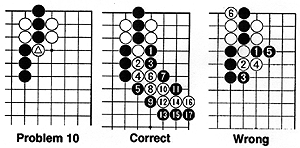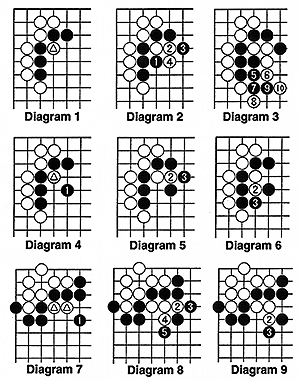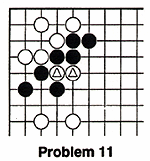Shuko Fujisawa, the first Kisei of the modern era
Shuko Fujisawa is one of the most remarkable players of the late 20th century. In 1975 at the age of 51, when most go players begin to lose their sharpness and enter a slow decline. Fujisawa won the Kisei title that had just been established by The Yomiuri Shimbun. Not only did he win this title, he defended it five successive times against the strongest players in the world.Fujisawa was certainly recognized as a great player even before winning the Kisei title. He had won the first and ninth annual terms of the prestigious Yomiuri-sponsored Meijin title, the Oza title for three straight terms from 1967, and the first term of the Tengen title, as well as a number of minor titles, but he was always in the shadow of Eio Sakata, whose career I outlined in last week's column.
The player who eventually dethroned him from the pinnacle of the go world was Cho Chikun, the current Kisei. In 1983, Cho emerged as the Kisei challenger at the age of 27. He already held three of the top four titles: the Meijin, Honinbo and Judan--and was considered Fujisawa's most dangerous challenger. However, the series started out as a one-sided affair with Fujisawa winning the first three games of this best-of-seven match, and it seemed that he was too strong for this young genius. But amazingly, Cho won the next four games to take the Kisei title and become the world's undisputed No. 1 player.
During his reign as Kisei, Fujisawa's results in other tournaments were ludicrous. He became famous as the player who held top position in the go world by winning only four games a year. After each successful defense, he would live the good life, but then, just a month before each title match, he would buckle down and get himself in condition for the upcoming title match, and invariably produce a number of masterpieces on the go board.
After he lost the Kisei title, Fujisawa underwent an operation and had most of his stomach removed. He subsequently had two more operations for cancer. He became just a shadow of the man he used to be, and it seemed that his go career was all but over. But in spite of this, his go skills did not desert him. In 1991 at the age of 66, he won the Oza title, to become the oldest player ever to win a title. Remarkably, he defended this title the following year against Koichi Kobayashi, who at that time held the Kisei and Meijin titles and was thus Japan's top player.
Fujisawa retired last October from tournament play. In spite of his age, his insight into the game is unrivaled and his advice is still sought by other professionals when they are baffled by a position. Perhaps no other player can match the originality and boldness of his ideas and his nearly infallible judgment of a position.
Answer to last week's problem
 In Problem 10, you were asked to capture the marked white stone. The ataris (threats to capture) of Black 1 and 3 are the correct moves. If White tries to escape with 2 and 4, Black ataris again with 5, and the ladder is set up. Black drives White to the edge of the board with the sequence to 17. White's stones will be captured on the next black move.
In Problem 10, you were asked to capture the marked white stone. The ataris (threats to capture) of Black 1 and 3 are the correct moves. If White tries to escape with 2 and 4, Black ataris again with 5, and the ladder is set up. Black drives White to the edge of the board with the sequence to 17. White's stones will be captured on the next black move.Black 3 in the correct answer is essential. It would be wrong for Black to play 3 in the next diagram because White 4 would atari a black stone. If Black rescues it by extending to 5, White ataris the three black stones at the top with 6, and Black's position collapses.
Capturing techniques: Nets
 In the position in Diagram 1, it may seem as if the marked white stone can be captured in a ladder. For example, Black might try to play 1 in Diagram 2. White runs away with 2 and Black plays the ladder-like move of 3. But White 4 ataris the four black stones on the left.
In the position in Diagram 1, it may seem as if the marked white stone can be captured in a ladder. For example, Black might try to play 1 in Diagram 2. White runs away with 2 and Black plays the ladder-like move of 3. But White 4 ataris the four black stones on the left.If Black tries to get out of atari by playing 5 in Diagram 3, White ataris with 6 and 8, and it is the black stones instead of the white ones that are caught in a ladder. This should be clear after White ataris with 10.
However, there is a way that Black can capture the marked white stone in Diagram 1. Black does this by jumping ahead of the marked white stone with 1 in Diagram 4. This move is somewhat like "casting a net.* The white stone cannot escape. If White plays 2 in Diagram 5, Black plays 3 and he can capture the two white stones on the next move. If White plays 2 in Diagram 6, Black puts the two white stones in atari with 3.
Diagram 7 is another example of casting a net to capture some stones. After Black 1, the two marked stones cannot escape capture. If White does try to escape by playing 2 and 4 in Diagram 8, Black plays 3 and 5, and the four white stones are one move away from being captured. If White first plays 2 in Diagram 9, Black blocks at 3. Again there is no way for the white stones to escape capture. Wherever White plays next, Black can put the white stones into atari and capture them on the next move.

Problem 11.
In this position, Black can capture the two marked stones by using the net technique described above. Where is the vital point for Black?
